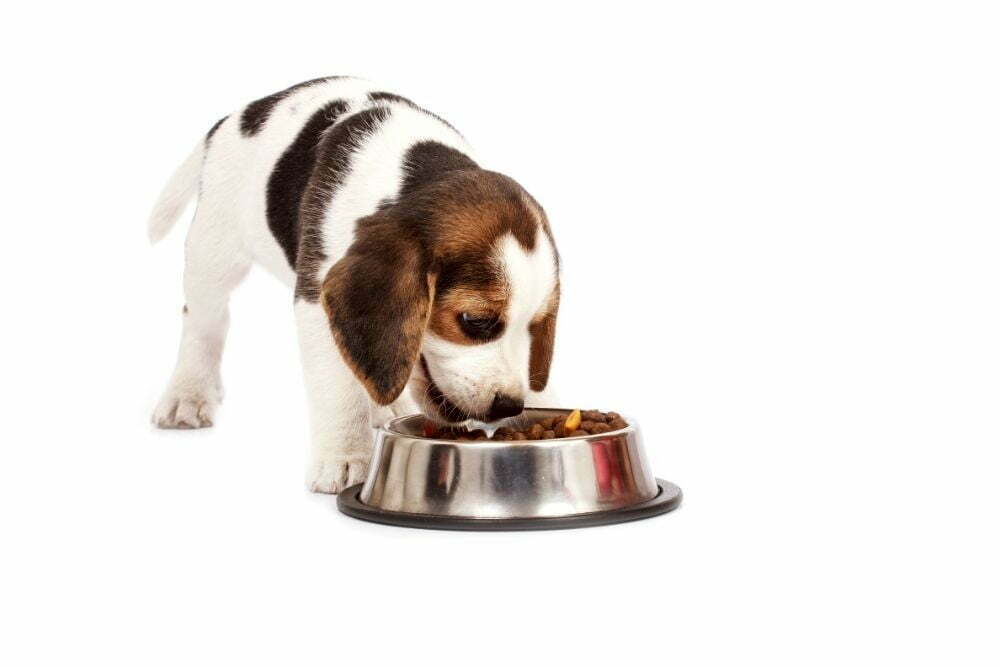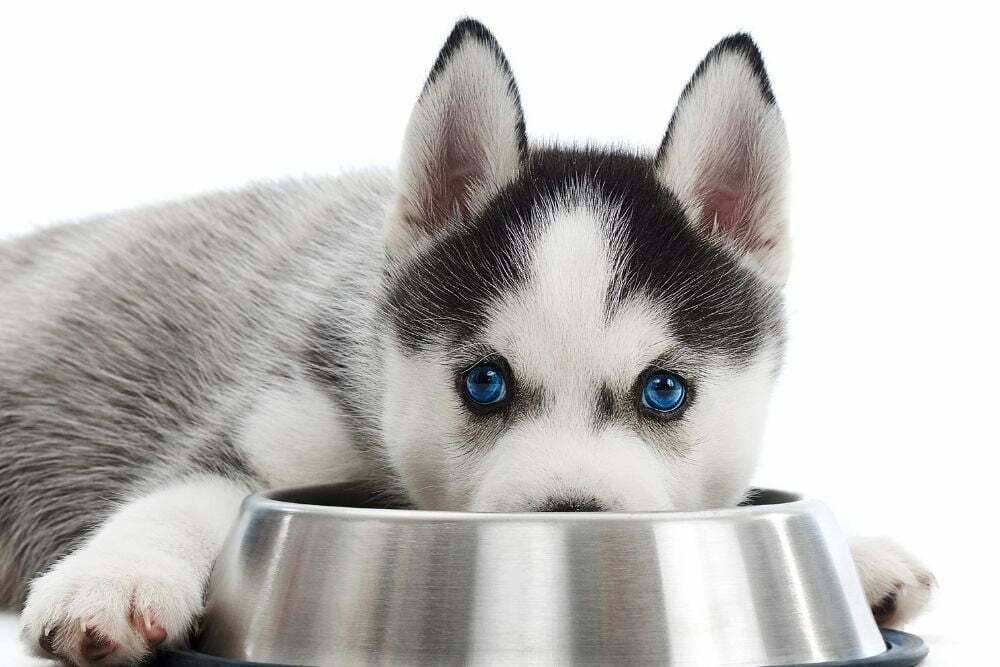
As a puppy owner, you’ll already have a feeding schedule established and are aware that you have to space your puppy’s meals out in accordance with their age.
However, now your puppy is getting a little older you might be wondering: when do you switch a puppy to 2 meals a day from 3?
In this article, I cover a general guide on when to switch a puppy to 2 meals a day, so you’re more informed when it comes to changing their mealtimes. That being said, this information should never be used to replace the advice of your veterinarian.
Keep reading to find out more.
When to Switch a Puppy to 2 Meals a Day
Once your puppy is 6 months old and up you can begin to start feeding them twice a day. Prior to this, it is likely that you have been feeding them 3 to 4 smaller meals a day for the first six months of their life.
A reputable breeder will be able to offer you advice about this, but more importantly, your puppy’s vet is the best option if you’re unsure about weaning your dog to two meals a day.
Puppies grow twenty times faster than adult dogs and so they require a special diet to aid their physical development. As your puppy experiences so many firsts as they’re growing in the first six months of their life, it is natural for them to use more energy thanks to all the playing, walking, and running around that they do!
From smelling new smells and experiencing new places and people, they burn through their calories rapidly. It makes sense, then, as they get a bit older this begins to calm down a little. At this point, you can reduce the number of times you feed them in a day to 2 meals.
Once your six-month-old puppy is ready to eat two meals a day, you’ll also notice that he’s not growing as fast as he was in his first six months. That being said, when your pup is ready, it’s natural to wean them off 3 meals a day to just 2. Alongside this, it means you have one less meal to remember if you live a busy lifestyle!
If in doubt, you should always make sure that you follow the guidelines on your puppy food packaging to ensure that they’re getting the right quantity for their age despite cutting down to two meals daily. Alongside this, your veterinarian is only a call away to offer their expertise and to discuss an appropriate feeding schedule.
When should you feed your puppy?
When it comes to feeding your puppy, it’s always best to split the two meals up. Although this is bound to differ between puppies and to vary slightly depending on your lifestyle, the majority of puppy parents choose to feed their puppies in the morning and the late afternoon.
It is recommended by pet feeding experts that you should feed your puppy their first meal of the day at around 7 am, or shortly after waking up in the morning. This will provide your dog with the energy for their morning walk and will ensure that they don’t become too hungry before their next meal!
The last meal of the day should be at 5 pm, as 5 pm to 7 am (or 14 hours) is the maximum time recommended to let your puppy go without food overnight.
Another benefit of sticking to this food schedule is that by feeding your puppy at 5 pm you are giving them ample time to digest their food before going to sleep. You can also take her for an evening walk after her meal or play a game of ball.
Generally, it isn’t recommended that you feed your puppy late at night as they will have more energy to burn before they go to sleep and it could possibly lead to unhealthy weight gain.
This can be avoided by feeding your puppy at 5 pm, as you can walk them afterward and they will have the opportunity to burn off the energy that the food has provided them with.
Another important advantage of feeding your puppy at 5 pm is that it means that it will reduce the chances of your puppy making a mess in the middle of the night or waking you up because they need to go to the toilet in the middle of the night.
How much should you feed your puppy twice a day?
The amount of puppy kibble you feed your puppy will primarily depend on their size and weight. However, that being said, your dog’s breed will also play a big role in how much your puppy should eat.
For instance, a medium to large breed of dog will require more food as a puppy than a toy breed of dog, as they are much bigger and generally require more activity.
The amount of food you give your puppy will also differ depending on whether you’re feeding your puppy wet or dry food. The tips below are designed to help you gauge if you’re feeding your puppy a healthy, balanced diet with the right amount of calories for their growth and development.
Check the feeding recommendations on the puppy food packaging – This is one of the easiest ways to check that you are feeding your puppy the right quantity of food every day. Feeding your dog with pre-packed food makes it easier for you to know how many calories you are giving your dog.
Breed-specific food is a great option to choose, too, as this will be specifically designed for your breed of puppy. That being said, if the package gives the total quantity per day, you will need to remember to split it into two half-meal portions.
Check with your veterinarian – If you’re still unsure of how much food to give your puppy, then clarifying a proper food schedule with your veterinarian is the best way to ensure that you’re giving your puppy the best diet possible.
Not only will they be able to recommend a good brand of food for their breed, but talking to a professional about your puppy’s health will also reassure any anxieties that you have about switching their diet from 3 meals to 2.
Limit the treats that you give your puppy – It is also worth mentioning that you shouldn’t overdo it on treats. Bear in mind that their treats should take up no more than 10% of your puppy’s total food quota for the day. If you give them too many treats or encourage them to beg from the table during meal-times by feeding them scraps, then they could not only develop bad habits but may also begin to gain unhealthy weight.
However, the following points are a sure sign that you are overfeeding or underfeeding your puppy, and you should carefully monitor your dog’s diet if they are showing them.
Signs that You are Overfeeding Your Puppy
Your puppy begins to look chubbier than usual – Making sure that your dog remains a healthy weight is important for their overall health and wellbeing. Your dog becoming overweight can be a health concern for many reasons, including diabetes, which is a condition you will have to monitor closely if they develop.
If your dog begins to look overweight, you might want to adapt their diet and activity accordingly whether that’s cutting the extra treats you give them out of their diet or increase how long you take them for their daily walks.
Signs that You are Underfeeding Your Puppy
Your puppy’s ribs are showing – The rib cage is a good indicator of whether you are feeding your puppy enough food or not. You should be able to feel individual ribs, but not see the definition of each rib.
This is a good rule of thumb to follow if you are unsure. If you see visible ribs, then it is highly likely that your dog is hungry and you need to give them more food.

When can I take my puppy walking after I feed them?
It’s really important that you don’t take your puppy walking straight after feeding them. They need time to digest their food just like their human parents do, too! Dogs who exercise before or after eating can develop bloating.
Generally speaking, it is recommended that you give your puppy at least an hour before you attempt to walk or play a game with them in the yard.
Alongside this, you should always wait at least 15 to 30 minutes after a walk to feed them, as the same rule applies. If you don’t allow them the time to digest their food properly or for their stomach to settle after exercise, then you increase the risk of your dog developing abdominal bloating which can be incredibly uncomfortable and painful for them.
Although this is mostly a problem with large breed dogs, bloat is a digestive problem that causes the stomach to blow up like a balloon and can affect a variety of breeds and can be fatal in severe cases. That being said, while they’re often desperate to play whenever you say so, it’s important for you to discourage this to prevent your puppy’s stomach from bloating.
When should you switch your puppy to adult food?
Generally speaking, you should keep your puppy on puppy-specific food until they’re 12 months old and are considered an adult.
Puppy food is full of extra nutrients and calories to meet your puppy’s growing needs and development. However, as they mature, they need less of the rich nutrients that puppy food focuses on.
While it’s essential that you don’t switch your puppy to adult food too soon, it’s just as important that you don’t keep unnecessarily feeding them puppy food for too long.
Feeding your dog a rich diet for too long could lead to obesity and a variety of other health issues as they develop into adulthood. That being said, then, it’s important that you make the switch when your pup reaches 12 months of age or matures!
However, it is important to note that different breeds mature at different rates. While smaller breeds tend to mature quicker, larger breeds take more time. For instance, a Dachshund tends to mature from anywhere between 7 to 10 months.
On the other hand, large breeds can take anywhere from 12 to 16 months to fully mature. Bearing this in mind, then, the switch should be done gradually depending on the breed of dog that you have.
The key with switching your puppy’s food is patience! Dog’s can have incredibly sensitive stomachs. By introducing adult food to your puppy’s diet over one or two weeks, you will allow them the time to adjust to it slowly.
If you switch their diet too quickly, you could end up making your puppy very ill and could cause them to have an upset stomach. That being said, you should wean them off their puppy formula slowly to ensure that they manage the switch as well as they can.
In Summary
You can begin to think about switching your puppy’s diet from 3 meals to 2 when they have reached six months of age. If in doubt, it’s always best to seek professional advice from your veterinarian.
